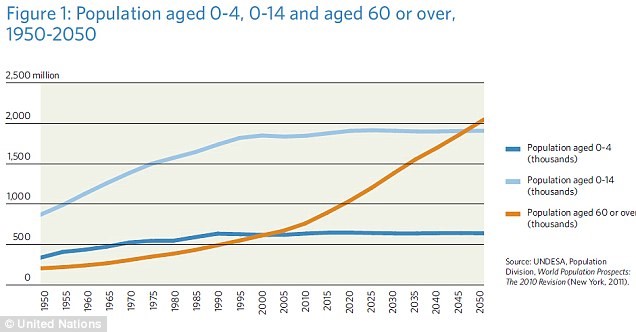News
January 20, 2015
By Nuritas
Nutritional Ageism

By: Meaghan Lee-Erlandsen and Dr. Nora Khaldi

An emerging trend that we have been charting is the global population increase of persons aged 60 and over. This demographic has seen huge growth over the past few decades and is projected to continue growing at a staggering rate as birth rates in many countries are decreasing and people are living longer lives (Figure 1). Incredibly, it is estimated that 1 in every 5 individuals will be aged 60 or over by 2050 with estimates higher in particular countries [1]. Japan, for instance, approximates that 1 in 3 people will be aged 60 or over by 2050 [2].

Image Source: UNFPA
It becomes clear that maintaining the health of this demographic is of great importance not only for societal and economic reasons (i.e. health services) but, most significantly, for the happiness of the individual. Developing new ways of maintaining this population’s health, that are not pharmaceutical drug based, with their known side-effects, but natural and scientifically proven to be efficacious, is of great importance and, ultimately, very attractive to this age group.
Interestingly, there is a huge gap between the increase in this population and what is currently on the market for this demographic in terms of natural alternatives such as functional food and dietary supplements. Indeed, most of the current functional food products target the 25-45 age range. Not surprisingly, this age group has very different needs than those aged 60 and over.
At Nuritas™, we firmly believe that this gap should be addressed in terms of understanding the interaction between nutrition and the aging body. We think that it is the duty of every food and dietary supplement company to push the science in this direction.
It is essential then to understand the issues facing the over-60 demographic and to develop ingredients and products that truly address their concerns, ensuring that this nutritional ageism is stopped. We have highlighted 3 key issues that provide direction for product development.
1. Direct Health Concerns
The direct health concerns of individuals over 60 years of age include eye, joint, bone, skin, and heart health, as well as issues regarding high cholesterol. Diabetes is also becoming very prominent in this group and is projected to increase dramatically. In the U.S. for instance, it is estimated that a staggering 1 in 3 people will be diagnosed with diabetes by 2050 [3].
With many over-60s making food decisions based on these immediate health concerns, manufacturers have begun, and will need to steadily increase, development of products that address such issues. It is promising to see that products claiming bone health for example, have increased by at least 200% in Western Europe over a period of 3 years (2010-2013) and are estimated to increase further as this population grows (Innova Market Insight).
2. Indirect Health Concerns
Another concern regarding this demographic are health problems that accumulate over time and lead to serious issues later on in life. These include such issues as muscle loss and brain health. After the age of 30, the body’s composition starts to change with a reduction in muscle mass of between 3-8% each decade [4].The reduction in muscle mass can be more than 50% for those over 80 years of age [5]. Muscle loss or degeneration associated with such diseases as sarcopenia, is a major cause of mobility reduction and is also associated with direct health concerns mentioned above, such as joint health, diabetes, etc.
Protein rich foods and protein supplements will be a major product for this age group as protein deficiency and malnutrition become an increased issue due to muscle loss. Again, it is encouraging to see the market for products with protein claims has increased by 192% from 2010 to 2014 in Western Europe and is expected to grow steadily (Innova Market Insight).
Additionally, another indirect health concern that we have learned of recently as part of a new discovery, referred to as the “Microbiome Mutiny Hypothesis”, shows how age and illness can affect gut bacteria in that long-living, health-benefitting microbiome, at the sign of illness or older age, can turn into virulent microbiome that try to kill their host. Developing ingredients that can reduce this effect is of great importance for the health of persons aged 60 and over.
3. Labelling
Labelling plays a major role in the food choices of this demographic. They are looking for healthy and natural products, with an added health benefit, that directly address their needs. However, they certainly do not want to be associated with a word such as “old” when searching for such products. Some companies have been intelligent in proposing packaging and advertising that showcase the reality of active over-60s, but there is still a lot to be done regarding the branding towards, and portrayal of, this demographic.
Furthermore, this demographic, as well as the 25-45 year olds, will benefit from easy twist jar lids, extra grip pull tabs for sealed microwavable trays, and easy-to-read labels. Some products aimed at this demographic include clear, large fonts, smaller portions, and specific health claims in bold and this trend will need to increase as the population grows.
With this growing demographic comes the opportunity for many different entities to address the needs of this population and provide services and products aimed at ensuring their happiness and health.
At Nuritas™, we look forward to ensuring we are at the forefront of understanding and addressing the health needs of this demographic and will continue to gear many of our services and ingredients towards this underserved group in order to help them live longer, happier and healthier lives.
Overall, as this population increases, we hope that food and supplement companies around the world rise to the occasion and invest in the science of nutrition for the over-60 demographic.
1. http://www.un.org/esa/population/publications/worldageing19502050/pdf/90chapteriv.pdf
2. http://www.un.org/esa/population/publications/worldageing19502050/pdf/90chapteriv.pdf
3. http://www.cdc.gov/media/pressrel/2010/r101022.html
4. http://www.ncbi.nlm.nih.gov/pmc/articles/PMC3276215/
5. http://www.ncbi.nlm.nih.gov/pmc/articles/PMC3276215/





 Previous
Previous
